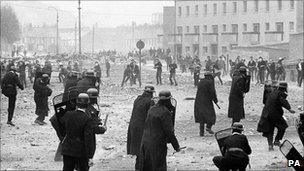The changing face of Londonderry
- Published

Police battle with rioters in the Bogside area of Londonderry in August 1969
"I have a new story to tell. I need to tell a new story. Just say yes."
That is how a film, external produced by the team behind Londonderry's bid to become the first UK City of Culture ends.
It is a city famous for its walls, its siege and as the city where the Troubles began with the Battle of the Bogside in 1969.
Whether you call it Londonderry, Derry or Stroke City, all are agreed it has a rich and varied history, but during the Troubles few could have foretold that it could one day be a City of Culture.
While the earliest reference to Derry comes from 546 AD when a monastery was built by St Columba, it was in the 1600s that the city we see today began to take shape.
2013 will mark the 400th anniversary of the building of the city's walls.
However, the city is known to many around the world for the violence that marred it during the Troubles.
Sectarianism and religious intolerance was not something that was confined to recent times; religion has caused difficulties in the city throughout its history.
In 1689, the city was under siege for more than 100 days, as forces loyal to former Catholic King James II tried to oust those who were loyal to the Protestant William of Orange.
The siege was eventually broken by the Royal Navy, but the city's walls were not breached and the Jacobite army withdrew.
In 1921, with the partition of Ireland, Derry found itself a border city in Northern Ireland. Many nationalists in the city were horrified and an Anti-Partition League was established.
However, when Derry Corporation reverted to unionist control in the local government elections in 1923, appeals to the Boundary Commission, set up in the wake of partition, for the city to be included in the south were fruitless.
Political discrimination in the city on the grounds of religion was evident. Electoral boundaries in the 1920s and 1930s were changed to make sure a smaller Protestant electorate had more councillors than the larger Catholic population.
Change of image
A civil rights demonstration in the city in 1968 was banned by the government.
During three days in August 1969, riots raged in the Bogside. The RUC were unable to maintain peace, and for the first time British troops were deployed on the streets of Londonderry.
Less than three years later, British troops returned to the streets of Derry, this time killing 13 people on a day that was to become known as Bloody Sunday.
Derry was a city that needed to change its image to the world, and those behind the bid team for the 2013 City of Culture hope they have achieved this by highlighting the city's rich cultural heritage.
Derry was depicted as a city that embraced its past and used it to showcase the present and future.
In the latest Lonely Planet travel guide, the city's people were described as "warm, witty and welcoming".
Derry is now a major draw for tourists, with the walls, the Bogside murals and lively local music scene, all must-sees.
Famous son and Nobel Prize winner Seamus Heaney was one of many bid supporters.
"Even in darker times, there was always something tonic about the spirit of people here, but prospects of a better future have strengthened resolve, and signs of progress are evident in all spheres of life not least in the cultural area," he said.
"At the beginning of the Northern Ireland troubles, the poet John Montague wrote - with specific reference to events in Derry/Londonderry - that 'old mould are broken in the north.'
"It seems to me that we now have a timely and unique opportunity to demonstrate to ourselves and to the world that a new mould and a new life have been shaped in the meantime."